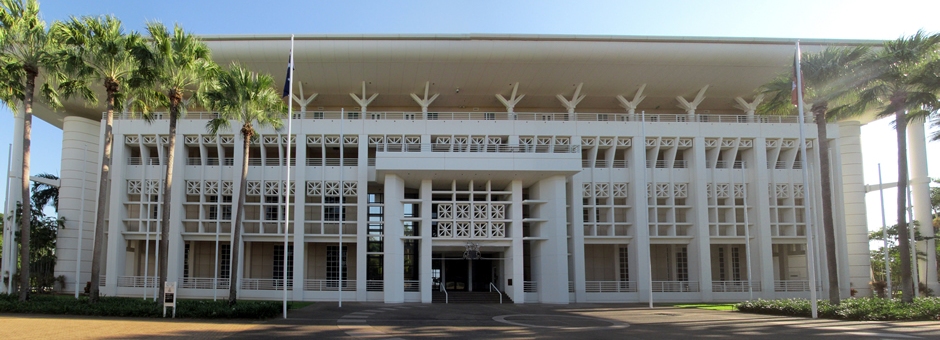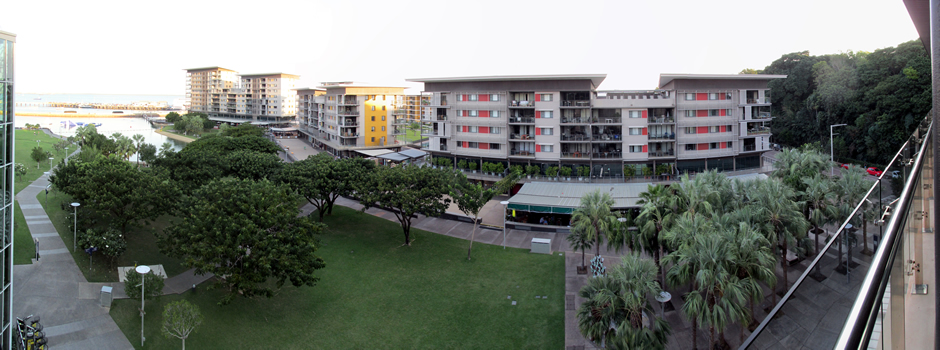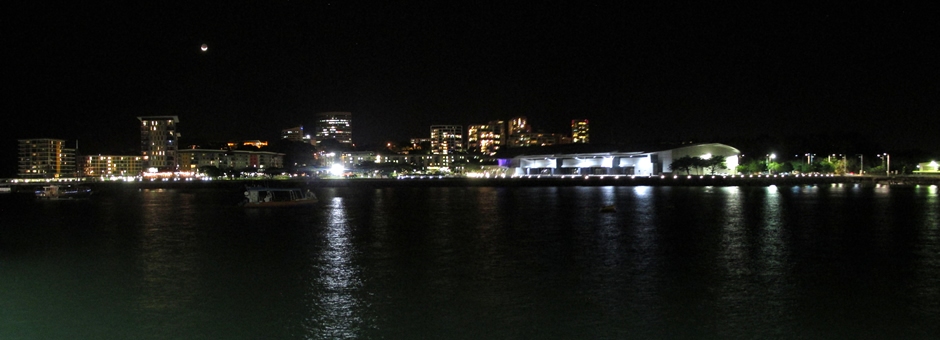Darwin is the capital, largest city and chief port of Australia's Northern Territory. It is the country's only tropical capital and most northerly, and is situated on the Timor Sea. The city's Harbour, Port Darwin, was found in 1839 by Lieutenant John Lord Stokes who was a surveyor aboard the HMS Beagle. The ship's captain, Commander John Clements Wickham named it after Charles Darwin, the famous British naturalist; Darwin had sailed with them on the earlier second expedition of HMS Beagle.

Above: Panoramic stitch (perspective) of Parliament House
The site of the modern city was not settled until 1869 and the settlement was first known as Palmerston, until being renamed after the harbour in 1911 when the Territory changed administration from South Australia to the Austra1ian Commonwealth. Originally a pioneer outpost, Darwin's development was helped through the advance of air services during the 1930s and later from its use as a fuelling and military base during World War II. Darwin suffered from heavy bombing by the Japanese during World War II. It was extensively rebuilt and officially listed as a city in 1959. In total, Darwin has been almost entirely rebuilt four times. As well as the Japanese bombing, three major cyclones have caused extensive devastation; one in 1897, one in 1937 and Cyclone Tracy in 1974, which damaged or destroyed nearly all of the city resulting in two thirds of the residents being evacuated. With government assistance, Darwin was rebuilt after Cyclone Tracy and today, with a population of around 136, 000, is one of the most modem cities in Australia.

Above: Panoramic stitch looking down towards Darwin Waterfront (to left)
The city served as the Top End's regional centre for a developing pastoral and mining hinterland. The economy is dependent on government business and a wide range of industries including food processing, tile and brick-making and the export of various goods. The city is affluent, cosmopolitan, and multicultural, in part due to an economic boom brought about by an increase in mining-related activities and also, tourism (either direct or indirect, as a stopping off place on the way to National Parks such as Kakadu or Litchfield). The city is the terminus of east- and west-coast shipping routes, the Stuart Highway (which runs all of the way down to Port Augusta, South Australia, in the south) and of the Adelaide–Darwin railway along which runs the famous passenger train, The Ghan. Historically, it has also been at the end of the overland telegraph line to Adelaide, forming a link here with a submarine cable which runs all the way to England.
There are plenty of sites to see in the city both on land and on water, and as well as the attractive harbour area, the city is not short of cafes and restaurants, historical sites, museums and exhibitions, galleries, markets, parks and gardens and entertainments. A brief description of some of the city's attractions featured on this (far from comprehensive) web page follows the thumbnail gallery below. In addition, a large number of the latter photos are taken from the Territory Wildlife Park (in Berry Springs) - a reflection of the time spent here (allow plenty!).
In the centre of Darwin stands Parliament House [Further up the page and Photos 3 & 24, above]. The building opened in 1994 and is the seat of the Northern Territory Legislative Assembly, which until then had met in various temporary buildings. Built in a post-modern come colonial style, it is designed to withstand the city's monsoonal climate. The building is also home to the Northern Territory Library and free tours are available on Saturday mornings. Following on in the city itself, the waterside Bicentennial Park [Photos 8-14, 18 & 19] runs the length of Darwin's Esplanade from Doctors Gully to Lameroo Beach. Inside the park stands a Cenotaph which commemorates Australian servicemen and women who have served in conflicts in which Australia has been involved. Also honoured are two hundred Remarkable Territorians remembered with hand painted tiles positioned along the Esplanade. Near Bicentennial park stands Lyons Cottage [Photos 15 & 16]. This was the city's first stone residence (1925) and formerly housed executives from the British Australian Telegraph Company. It is now a museum and retail outlet. Ruins of the former Palmerston Town Hall [Photo 27]. Built in 1883, these old ruins can be seen walking along Smith Street. Not far from the Smith Street Mall, this area of the Darwin is strong in history and is part of the Darwin City Heritage Walk. Christ Church Cathedral [Photos 30-34] This Anglican Church became a cathedral when the Northern Territory diocese was created in 1968 out of the larger Diocese of Carpentaria. The cathedral (completed 1977) was rebuilt after Cyclone Tracy in 1974 almost totally destroyed the previous structure. It incorporated the surviving porch of the old church. The back wall of the octagonal building was built using reclaimed stone from the old church. The cathedral houses recovered and repaired treasures from the original structure, art and a stained glass memorial. The Waterfront Precinct [Photos 36-49 taken from here] can be accessed from the city centre via a skybridge, elevated walkway and lift. the redevelopment of this part of the city represents a major investment and contains hotels, boutique restaurants, shops and a cruise-ship terminal. There is an inland beach and a wave and recreation lagoons, as well as parkland with free Wi-Fi. The old Stokes Hill Wharf is set around a harbour area and at the end of it is a refurbished warehouse containing a food centre, From here, there are great views back towards the city and various harbour cruises depart. Near here (not shown) are World War II oil-storage tunnels, which are open to the public. Built in 1942, they were never used. As mentioned earlier, the sites featured on this webpage is a far from exhaustive list of things to see and do in this Australia's most northerly capital.
Further afield is the Territory Wildlife Park [Photos 59-160]. The park is on Cox Peninsula Road, Berry Springs - a 45 minute (60km) drive from the city of Darwin. Covering some 400 ha of natural bushland, it contains native animals and plants representative of Northern Territory, Top End tropical monsoonal environments, in particular. Some main things to see here include the Billabong, where there are live feeding displays of Pelicans and freshwater crocodile, the 'Flight Deck' with live demonstrations of various birds (of largely, prey), the nocturnal house, the aquarium, which includes a transparent underwater tunnel, 11 different habitat aviaries and a large walk-through aviary and the woodland walk area where at certain times, it is possible to get up close to watch kangaroos and wallabies being fed. The park can be walked around, but due to its size and the local climate, it may well be preferable to take the hop-on shuttle trains that run around the 4km perimeter road. It is a good idea to get here early in the day and allow plenty of time, to take advantage of the various feeding demonstrations and displays included in the ticket price (map and times of these provided on admission).

Above: Darwin by night as seen from old Stokes Hill Wharf
References and Further Reading
1. Exploring the Stuart Highway and Oodnadatta
Track Adelaide to Darwin. Balhannah, SA: Tourist Information
Distributors Australia.
2. Rawlings-Way, C., Worby, M. and Brown, L.
(2013). Central Australia. Footscray, Vic.: Lonely Planet.
3. Darwin on
Wikipedia
Here
4. In situ public information boards
Back to Top